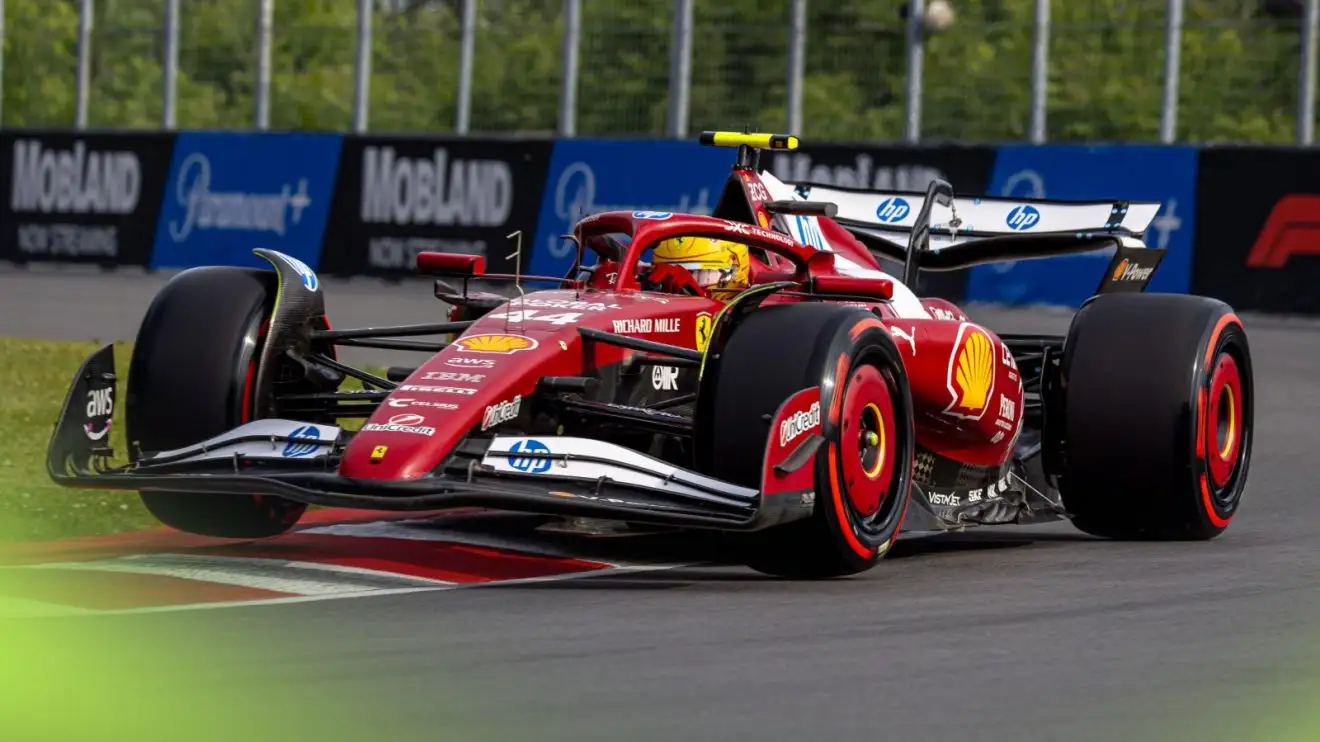Lewis Hamilton’s Canadian GP Frustration Reveals Bigger Ferrari Crisis
Lewis Hamilton looked like he had something going in Canada—a clean start, calm tire management, and that signature composure behind the wheel that’s become his hallmark over a legendary Formula 1 career. The early laps of the Canadian Grand Prix seemed to promise a strong finish, maybe even a surprise result if strategy or weather chaos played into his hands. But what followed wasn’t just a dip in performance—it was something Hamilton himself would later describe as “devastating.” And as it turns out, it wasn’t just about a broken car. It was about broken confidence in a Ferrari project that’s starting to show some worrying cracks.

A Strong Start Undone by Mystery
From the green light, Hamilton was dialed in. Running near the front of the midfield pack, he kept pace in a Ferrari SF-25 that, while not dominant, appeared competitive enough for a top-five finish. Tire wear was under control. His radio exchanges with race engineer Riccardo Adami were calm and focused. All signs pointed toward a solid result.
But then, something changed. Gradually, Hamilton began losing time—not in dramatic, obvious chunks, but in subtle tenths and hundredths that quickly became a red flag in a hyper-competitive field. When you’re racing McLarens, Red Bulls, and even the surging Aston Martins, small drops in pace quickly become big problems.
Eventually, Hamilton was told he had sustained some kind of car damage. The problem? Neither he nor the Ferrari engineers had any idea how or when it happened. There were no obvious impacts, no excursions over high curbs, no contact with other cars—just an unexplained loss of performance.
The Groundhog Incident
Post-race, the truth emerged: Hamilton had hit a groundhog.
Yes, a groundhog.
Circuit Gilles Villeneuve is famous for its picturesque island setting and, less glamorously, its frequent run-ins with wildlife. Groundhogs have become an unfortunate hallmark of the Canadian GP, often darting across the track during sessions. This time, one wasn’t so lucky.
Unseen by Hamilton, the animal ran in front of his car during the race. The resulting impact tore a chunk out of the floor on the right-hand side, destroying crucial aerodynamic elements. That loss of downforce explained the pace drop. But for Hamilton, the revelation stung far more than a technical diagnosis.
“I love animals,” he said. “That’s horrible. That’s devastating.”
It wasn’t just the floor damage, either. Hamilton reported developing brake issues later in the race and suffered from poor track positioning after a strategy misstep left him stuck in traffic. He still managed to finish sixth, salvaging points from a race that quickly became a nightmare. But the bigger story was what happened off the track—and what it revealed.
Cracks in the Ferrari Dream
Hamilton’s tone in post-race interviews was subdued, frustrated, and—unusually—candid. He acknowledged the team’s efforts but made clear that more needs to change. The SF-25 isn’t fast enough. The upgrades aren’t coming quickly enough. And crucially, the way the team operates behind the scenes appears to be part of the problem.
“There’s a lot that needs to change before we’re back at the front,” Hamilton said. “So many things I wish I could tell you.”
It was a loaded comment—cryptic, but pointed. For a driver renowned for his professionalism and carefully measured public remarks, it was an unmistakable shot across the bow. The implication? Ferrari’s issues aren’t just technical—they’re systemic.
This isn’t just about ride height or rear-end stability. It’s about culture. Leadership. Cohesion. A team that, in Hamilton’s view, still doesn’t have the internal alignment required to return to championship contention.

Backing Fred Vasseur—and Sending a Message
As rumors swirled during the Canadian GP weekend about the possible dismissal of team principal Fred Vasseur, many expected Hamilton to dodge the speculation. Instead, he did the opposite.
“Fred’s the main reason I’m in this team,” Hamilton said. “I want Fred here.”
This was more than a vote of confidence. It was a statement. Hamilton didn’t just back Vasseur—he attached his own future to him. In a paddock where politics often outweigh performance, Hamilton’s public support for Vasseur was a not-so-subtle warning to Ferrari’s upper management: make rash decisions, and you might lose more than just a team boss.
It’s a clear sign that Hamilton’s vision for Ferrari extends beyond this season. He isn’t just here to race—he’s here to build. But he can’t do that alone.

Silverstone: Ferrari’s Last Stand?
Hamilton’s frustrations are shared by many. Former teammate and rival Nico Rosberg recently remarked that Hamilton’s patience is “hanging by a thread,” and that Ferrari’s upcoming upgrade at Silverstone could be the last chance to salvage momentum before the team shifts focus to its 2026 car.
According to reports, Ferrari is preparing to bring its final major update of the season to the British Grand Prix—a rear suspension fix aimed at resolving balance and consistency issues. Beyond that, the focus may turn fully to Project 678, the internal code name for Ferrari’s 2026 car built to new regulations.
But that’s a dangerous gamble.
Hamilton didn’t join Ferrari to be a placeholder for the future. He joined to compete now. If Silverstone’s upgrade doesn’t deliver meaningful gains, the narrative inside Maranello could quickly turn toxic. And Hamilton, who has been remarkably diplomatic so far, may not hold back much longer.
What’s Next?
It’s not the first time Ferrari has been in crisis. But what makes this situation different is the presence of a seven-time world champion who knows what it takes to win—not just behind the wheel, but inside an organization.
Hamilton’s post-race comments weren’t just about heartbreak over hitting an animal or frustration with a flawed car. They were a call to action. A signal that he’s willing to do the hard work—but expects Ferrari to meet him with the same intensity.
As the season approaches its midpoint, Ferrari’s choices will become clear: either align with Hamilton’s vision and begin a genuine rebuild—or risk losing the most high-profile driver the team has had since Michael Schumacher.
One thing is certain: Hamilton didn’t join Ferrari to fight for P6. And if things don’t change soon, the world will stop asking whether he can save Ferrari—and start asking whether Ferrari is even capable of being saved.
Full Video:





